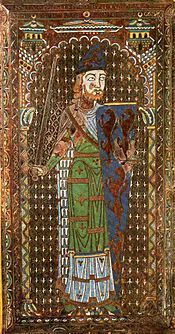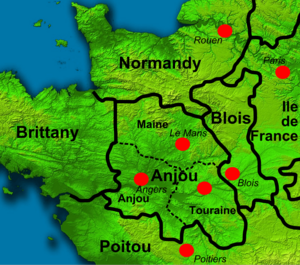Geoffrey Plantagenet, Count of Anjou facts for kids
Quick facts for kids Geoffrey of Anjou |
|
|---|---|
| Count of Maine and Mortain | |

Enamel effigy from his tomb at Le Mans. His decorated shield suggests early origins of the three lions of the Royal Arms of England.
|
|
| Count of Anjou | |
| Reign | 1129 – 7 September 1151 |
| Predecessor | Fulk the Younger |
| Successor | Henry Curtmantle |
| Duke of Normandy | |
| Reign | 1144 – 1150 |
| Predecessor | Stephen |
| Successor | Henry Curtmantle |
| Born | 24 August 1113 |
| Died | 7 September 1151 (aged 38) Château-du-Loir, France |
| Burial | Le Mans Cathedral, Le Mans |
| Spouse | |
| Issue Detail |
|
| House | Plantagenet (founder) |
| Father | Fulk, King of Jerusalem |
| Mother | Ermengarde, Countess of Maine |
Geoffrey V (born August 24, 1113 – died September 7, 1151) was an important French ruler. He was also known as the Handsome or Plantagenet. He became the count of Anjou, Touraine, and Maine in 1129. Later, he also became the Duke of Normandy in 1144.
Geoffrey's marriage to Empress Matilda was very important. Matilda was the daughter of King Henry I of England. Their marriage led to the start of the Plantagenet dynasty in England. This family ruled England for many centuries. The name "Plantagenet" came from Geoffrey's own nickname. His family's home region, Anjou, also gave its name to the "Angevin" kings and the "Angevin Empire" in the 1100s.
Contents
Early Life and Nickname
Geoffrey was the older son of Fulk V of Anjou and Ermengarde of Maine. He got his nickname "Plantagenet" from a special yellow flower. He used to wear a sprig of broom blossom (called genêt in French) in his hat.
A writer from that time, John of Marmoutier, described Geoffrey as handsome. He had red hair, a cheerful personality, and was a great fighter. King Henry I of England heard good things about Geoffrey. So, he sent people to Anjou to arrange a marriage. He wanted Geoffrey to marry his daughter, Empress Matilda.
Matilda was 25 years old, and Geoffrey was 15. Both agreed to the marriage. On June 10, 1128, King Henry made Geoffrey a knight in Rouen. This was a special ceremony before the wedding.
Marriage to Empress Matilda
Geoffrey and Matilda got married in 1128. This marriage was meant to create a lasting peace. It connected England, Normandy (which England controlled), and Anjou. Matilda was eleven years older than Geoffrey. She was very proud of being a former empress, even though she was now a countess. She kept her empress title for the rest of her life.
Their marriage was sometimes difficult, but they were happy together. They often spent long periods apart. They had three sons: Henry, Geoffrey, and William.
Count of Anjou and Duke of Normandy
The year after Geoffrey's marriage, his father left for Jerusalem. His father later became king there. Geoffrey stayed behind and became the count of Anjou.
When his father-in-law, King Henry I of England, died in 1135, Geoffrey helped Matilda. She wanted to claim her right to rule Normandy. Some areas supported her, but England chose her cousin, Stephen of Blois, as king. Normandy soon followed England's choice.
In 1139, Matilda arrived in England with 140 knights. She was attacked at Arundel Castle by King Stephen. A civil war, known as the Anarchy, then began in England. King Stephen was captured in 1141 and put in prison. An important church meeting declared Stephen was no longer king. They announced Matilda as "Lady of the English."
Between 1142 and 1143, Geoffrey took control of much of Normandy. On January 14, 1144, he entered Rouen, a major city. He officially became the Duke of Normandy in the summer of 1144. In 1144, he also started a religious house in Anjou.
Geoffrey ruled Normandy until 1149. Then, he and Matilda gave the duchy to their son, Henry. King Louis VII of France officially approved this decision the next year. Geoffrey also stopped three rebellions by powerful lords in Anjou. These rebellions slowed his progress in Normandy. They also prevented him from helping Matilda more in England.
In 1153, the Treaty of Wallingford was signed. This agreement said that Stephen would remain King of England for life. But after Stephen died, Henry, Geoffrey and Matilda's son, would become king. This treaty marked the beginning of the Plantagenet era in English history.
Death
Geoffrey died suddenly on September 7, 1151. A writer named John of Marmoutier said Geoffrey was returning from a meeting when he got a fever. He arrived at Château-du-Loir, collapsed, and died. He was 38 years old.
His wife and sons were still alive after him. Geoffrey was buried at St Julien's Cathedral in Le Mans, France. His son Henry took his place as the head of the Plantagenet family and Duke of Normandy.
Children
Geoffrey and Matilda had three children:
- Henry II, King of England (1133–1189)
- Geoffrey, Count of Nantes (1134–1158)
- William, Viscount of Dieppe (1136–1164)
Geoffrey also had other children. These were:
- Hamelin, who married Isabel de Warenne, 4th Countess of Surrey.
- Emma, who married Dafydd Ab Owain Gwynedd, a prince from Wales.
- Mary, who became a nun and the head of Shaftesbury Abbey.
Early Heraldry
An enamel picture was made for Geoffrey's tomb by his wife. This picture is one of the earliest examples of heraldry in Europe. Heraldry is the system of designing and using coats of arms.
A writer from the late 1100s, Jean de Marmentier, wrote about Geoffrey. He said that in 1128, King Henry I of England made Geoffrey a knight. He also gave him a special badge with gold lions. A gold lion might have been Henry's own badge. Later, many of his family members used different lion designs.
The enamel picture shows Geoffrey with a blue shield that has gold lions on it. This looks like the same design later used by Geoffrey's grandson, William Longespee. This picture is one of the first real examples of a coat of arms. It also suggests how the English royal arms might have started.
See also
 In Spanish: Godofredo V de Anjou para niños
In Spanish: Godofredo V de Anjou para niños


